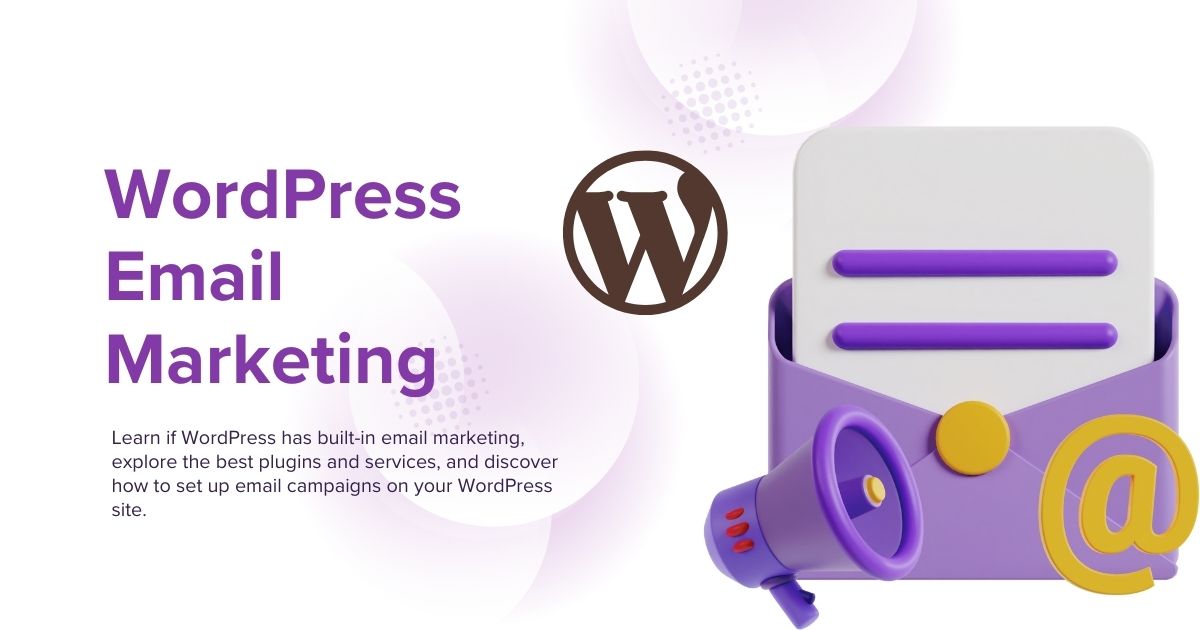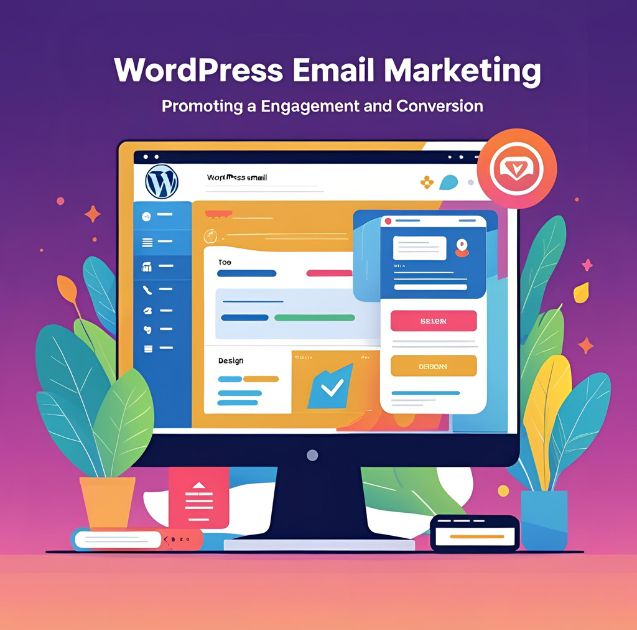
Many website owners wonder if WordPress includes built-in email marketing capabilities. The short answer is no—WordPress doesn’t come with native email marketing tools. However, this doesn’t mean you’re out of luck if you want to run email campaigns from your WordPress site.
WordPress serves as a content management system, focusing primarily on helping you create and manage your website content. Email marketing requires specialized features like subscriber management, automated campaigns, delivery optimization, and detailed analytics—capabilities that fall outside WordPress’s core functionality.
The good news? WordPress’s flexible architecture makes it incredibly easy to add powerful email marketing capabilities through plugins and integrations. Whether you’re a blogger looking to grow your audience or a business owner wanting to nurture customer relationships, you have numerous options to transform your WordPress site into an email marketing powerhouse.
This guide will walk you through everything you need to know about email marketing with WordPress, from the best plugins to choose from to step-by-step setup instructions.
WordPress Email Marketing: Plugins vs. External Services

When it comes to adding email marketing to your WordPress site, you have two main approaches: using dedicated plugins or integrating external email marketing services. Each approach has distinct advantages depending on your needs, budget, and technical expertise.
WordPress Email Marketing Plugins
Email marketing plugins install directly on your WordPress site, giving you complete control over your email campaigns. Popular options include MailPoet, Newsletter, and The Newsletter Plugin. These plugins typically offer subscriber management, email templates, and basic automation features.
The main advantage of plugins is convenience. Everything runs from your WordPress dashboard, making it easy to manage your content and email marketing in one place. You also maintain complete ownership of your subscriber data.
However, plugins come with limitations. They rely on your web hosting provider’s email sending capabilities, which can lead to delivery issues. Most shared hosting plans have strict email sending limits, and your emails might end up in spam folders more frequently than with dedicated email services.
External Email Marketing Services
External services like Mailchimp, ConvertKit, and Constant Contact specialize exclusively in email marketing. They offer superior deliverability, advanced automation features, and comprehensive analytics. These platforms have established relationships with internet service providers and follow strict sending practices to ensure your emails reach inboxes.
Integration typically happens through plugins or widgets that connect your WordPress site to the external service. You’ll create opt-in forms on your website, but the actual email sending and subscriber management occur on the external platform.
While external services usually cost more than plugins, they provide better deliverability rates, more sophisticated features, and dedicated customer support for email marketing issues.
Top WordPress Email Marketing Plugins

Let’s examine the most popular WordPress email marketing plugins and what makes each one unique.
MailPoet
MailPoet stands out as the most comprehensive WordPress email marketing plugin. It offers a visual email builder, automated welcome emails, and detailed subscriber analytics. The plugin integrates seamlessly with WooCommerce, making it excellent for e-commerce sites.
MailPoet’s free version allows up to 1,000 subscribers and 12,000 emails per month. For larger lists, you’ll need their premium service, which includes better deliverability through their sending infrastructure.
Newsletter
The Newsletter plugin focuses on simplicity and reliability. It provides basic email marketing features without overwhelming beginners with complex options. The plugin includes responsive email templates, subscriber management, and simple automation rules.
This plugin works well for bloggers and small businesses that need straightforward email marketing without advanced features. It’s completely free, though premium extensions add extra functionality.
The Newsletter Plugin
Don’t confuse this with the “Newsletter” plugin mentioned above. The Newsletter Plugin offers more advanced features, including A/B testing, detailed analytics, and professional templates. It’s designed for users who want plugin-based email marketing with enterprise-level features.
The free version provides solid basic functionality, while premium add-ons unlock advanced automation and integration options.
Best External Email Marketing Services for WordPress
If you prefer using dedicated email marketing platforms, these services offer excellent WordPress integration.
Mailchimp
Mailchimp remains one of the most popular email marketing services, offering a generous free plan that includes up to 2,000 subscribers and 12,000 emails per month. Their WordPress plugin makes integration straightforward, allowing you to create signup forms and sync subscriber data automatically.
The platform excels in template design, automation capabilities, and detailed analytics. Mailchimp’s user-friendly interface makes it perfect for beginners, while advanced features satisfy experienced marketers.
ConvertKit
ConvertKit targets content creators, bloggers, and online course creators. The platform emphasizes simplicity and powerful automation features. Their WordPress plugin enables easy form creation and seamless subscriber management.
ConvertKit’s strength lies in its tagging and segmentation capabilities, allowing you to send highly targeted campaigns based on subscriber behavior and interests.
Constant Contact
Constant Contact focuses on small businesses and provides excellent customer support, including phone assistance. Their WordPress integration includes customizable signup forms and automated list synchronization.
The platform offers extensive template libraries, social media integration, and event marketing features that go beyond basic email campaigns.
How to Set Up Email Marketing on WordPress
Setting up email marketing on your WordPress site involves several key steps, regardless of which solution you choose.
Step 1: Choose Your Email Marketing Solution
Decide between using a WordPress plugin or an external service based on your needs. Consider factors like subscriber list size, budget, desired features, and technical expertise. If you’re just starting out, a plugin might suffice. For serious email marketing efforts, external services usually provide better results.
Step 2: Install and Configure Your Chosen Solution
For plugins, install them through your WordPress admin dashboard under Plugins > Add New. Search for your chosen plugin, install it, and activate it. Follow the setup wizard to configure basic settings.
For external services, create an account with your chosen provider, then install their WordPress integration plugin. Connect your WordPress site to your email service account using the provided API key or authentication process.
Step 3: Create Opt-in Forms
Design attractive signup forms that encourage visitors to join your email list. Place forms strategically throughout your site—in your sidebar, footer, at the end of blog posts, or as pop-ups. Ensure your forms comply with privacy regulations by including clear consent language.
Step 4: Develop Your Content Strategy
Plan what types of emails you’ll send and how frequently. Common email types include welcome sequences, newsletters, promotional campaigns, and automated follow-ups. Consistency is key to building subscriber engagement.
Step 5: Monitor and Optimize
Track important metrics like open rates, click-through rates, and subscriber growth. Use this data to refine your email content, sending frequency, and targeting strategies.
Email Marketing Best Practices for WordPress Sites
Successful email marketing requires more than just sending messages to your subscribers. Follow these proven strategies to maximize your results.
Build Your List Organically
Focus on attracting genuinely interested subscribers rather than buying email lists or using questionable tactics. Offer valuable content, exclusive resources, or special discounts in exchange for email addresses. Quality subscribers engage more and generate better results than large lists of uninterested contacts.
Segment Your Subscribers
Not all subscribers have the same interests or needs. Segment your list based on factors like signup source, purchase history, engagement level, or content preferences. Targeted emails perform significantly better than generic mass mailings.
Optimize for Mobile
Most people check email on mobile devices, so ensure your emails look great on smartphones and tablets. Use responsive email templates and keep subject lines short enough to display properly on small screens.
Maintain Consistent Branding
Your emails should reflect your WordPress site’s branding and voice. Use consistent colors, fonts, and messaging to reinforce your brand identity and build recognition among subscribers.
Taking Your WordPress Email Marketing Further
Email marketing success comes from consistent effort and continuous improvement. Start with basic campaigns and gradually incorporate more advanced features like automation, segmentation, and personalization.
Remember that building a successful email list takes time. Focus on providing value to your subscribers, and they’ll remain engaged with your content and offerings. Whether you choose a WordPress plugin or an external service, the key is to start building relationships with your audience through regular, valuable email communication.
Consider testing different approaches to find what works best for your specific audience and goals. Email marketing remains one of the most effective ways to nurture relationships with your website visitors and convert them into loyal customers or readers.


















No Comments